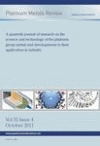-
oa Energy Storage and Transmission
Platinum Catalyses Chemical Closed-Loop System
- Source: Platinum Metals Review, Volume 30, Issue 4, Aug 1986, p. 174 - 182
-
- 01 Jan 1986
Abstract
Increasingly the energy needs of society will have to be met from renewable resources. The use of these is limited at present by their location, the technologies available to harness them and the major problems associated with their storage. One possible solution to these difficulties has now been demonstrated, and is described here, while further development wcrk is continuing. Hydrogen produced by any convenient means is used as a medium for energy storage and transmission. Close to its production site the hydrogen is catalytically reacted with toluene to yield methylcyclohexane; this is transferred safely by pipeline or container to the point of energy requirement where it is catalytically dehydrogenated. The hydrogen released is then available for use in a wide variety of ways, while the toluene is returned to the source for further hydrogenation, and the cycle is repeated.


